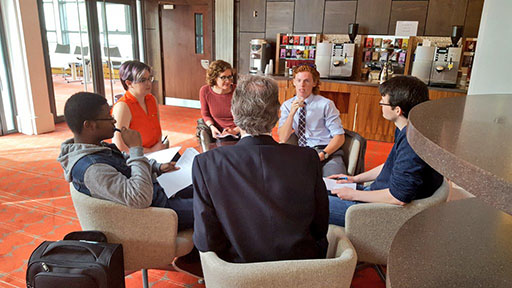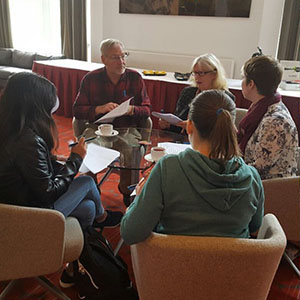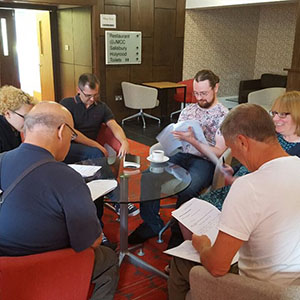= ASTRONAUTICAL EVOLUTION =
Issue 130, 19 September 2016 – 47th Apollo Anniversary Year
| Site home | Chronological index | About AE |
The Citizens’ Debate on Space for Europe
What it was all about
What’s the difference between the space agency and other departments of government such as health, social security or defence? Perhaps the difference is that, to the public, the purpose of the more traditional ministries is self-evident, while that of space is not so obvious at all?
The same would be true of research councils, of course, or of public support for the arts. Yet the space agencies have big big ambitions. Extremely costly ambitions: to send astronauts to the Moon and Mars, and set up permanent scientific bases on those worlds.
If their political masters are not willing to put up the funds, then the agencies must go behind the politicians’ backs and address the taproot of democratic power: the people. That, at any rate, seems to be the logic behind the European Space Agency’s new exercise in public consultation, the Citizens’ Debate on Space for Europe.
On 10 September, groups of members of the general public were assembled in capitals in all of ESA’s 22 member states simultaneously. In the UK the event took place in Edinburgh. I took the Caledonian sleeper train north to play my part as a typical (!) citizen.
The intention had been to involve 100 people in each country. I don’t know how it went elsewhere, but the UK debate was seriously under-subscribed: we began the day with only 18 participants, plus a few more who trickled in later in the day.
How the debate was organised

The format was as follows. The debate was divided into half a dozen sessions. In each session, first we all watched a video together, then we divided up into groups of six to discuss the issues raised. We had each been supplied with a form on which a number of questions were printed, with multiple-choice answers, plus room for our own individual comments. The purpose of the group discussions was not to reach a consensus, but simply to air the issues before deciding on our individual answers. Differences of opinion were expected, and were certainly in evidence in our group!
The results of the multiple-choice questions are being posted on the website. As can be seen there, the questions were wide-ranging, but at the same time as vague as multiple-choice questions usually are.
For example, one question asked how, “as a citizen” (as opposed to what?), I would rate my “level of trust” in ESA. Various options were provided: full trust, a high level of trust, a low level of trust, no trust at all, or no opinion. Clearly, we should only tick one box, but the question is ambiguous: does it mean trust in ESA’s technological competence, or trust in its strategic direction? My trust in the one is high, in the other is low.
The event rather resembled what I imagine a citizens’ jury would be like, but with one major difference: instead of expert witnesses, the videos presented vox pops: a series of sound-bites from various interviewees, answering a question they had just been asked. Some of the interviewees were astronauts such as Alexander Gerst or Samantha Cristoforetti, some were less well-known ESA people, many seemed to be random members of the public who had been buttonholed in the street. Coming from all around Europe, most of the clips were not in English and had been subtitled.
The point is, though, that the vox pops gave nothing but the briefest expression of the speaker’s opinion. No attempt was made at presenting any factual information or fact-based arguments, apart from an introductory video with bare-bones information such as that the number of countries in ESA was 22 and that it had been founded in 1975.
What does ESA really want to get out of this?
Several possibilities occur to me:
- ESA wants to change people’s views in favour of more spending on space exploration.
- ESA wants to poll people’s existing views and adjust its strategy in accordance with them.
- ESA feels there is a lack of clarity about its purpose, and is looking for inspiration.
- Some combination of the above.

Changing the views of the participants was certainly on the agenda. Several of the questions which appeared in the early sessions were repeated word-for-word in the final one – irritatingly, I thought. I only found out that this had been done deliberately when I reached a question asking whether I had changed my mind on any of the issues during the course of the day.
Clearly, I had not, but surprisingly almost half the participants thought they had, according to the results on the website. Yet the event was not structured around detailed fact-based arguments, which might have challenged previously held views, but around sound-bite-sized exchanges of opinions. So it seems that while this was indeed a goal, it was not the main one.
Regarding the second possibility: the results displayed on the website are organised purely as percentages of people making one choice or another. The Citizens’ Debate has therefore produced a detailed opinion poll. But since the participants were self-selected, the stated goal of representing the demographic pattern of each country has clearly not been met. In a citizens’ jury, I, for example, should have appeared as a witness, not as a deliberant representing the broader public. So the results do not have the validity of a normal public opinion poll. They cannot be used as a barometer of European public opinion in general, though they do summarise the views of its space-aware subgroup.
The third possibility, that ESA is casting around for some strategic vision that can consolidate its purpose and position in society, is suggested by the numerous questions which left space at the bottom for the reader’s own personal comments. This was a welcome admission of the limitations of the multiple choice question above. But what use will be made of them in practice? What will they do with the answers to the question as to which space industry professional one would like to meet over lunch, and what one would want to discuss with that person?

The trouble is that ESA already has a strategic vision. It is to rally the space agencies of the world and lead them in a super-Apollo programme to send their astronauts to the Moon and Mars. Thus to bring back the glory years of the Moon race, only this time with all nations working together. Or rather, with all space agencies working together, competing this time not against one another, but against those dark forces that would deprive them of their legitimate claim on the public purse.
So all in all I’m inclined to believe that the invitations scattered throughout the questionnaire to add personal comments were aimed more at flattering each participant and reinforcing their motivation rather than sourcing new ideas. On the other hand, I suppose that in the unlikely case that say 50% of respondents uses that space to push reusable spaceplane development, that might yet make an impression.
Clearly, I pushed for economically usable launch vehicles and space tourism whenever I could, and mentioned Skylon a couple of times on the questionnaire, as being a key technological breakthrough towards this goal. We shall see whether Skylon in particular or fully reusable launch vehicles in general make it into the light at the end of this consultation; they were not mentioned in the questionnaire, and neither was anybody from Reaction Engines or SpaceX or from a similar company included in the vox pops videos.
Please send in comments by e-mail.
Interesting and relevant comments will be added to this page.
| Site home | Chronological index | About AE |